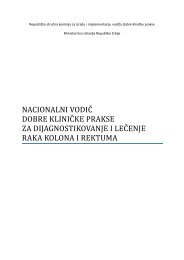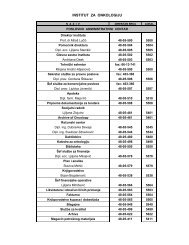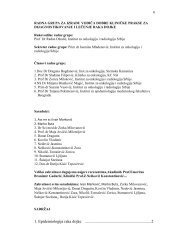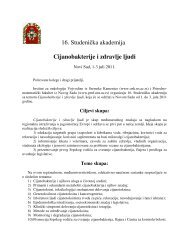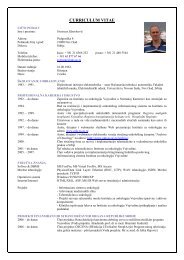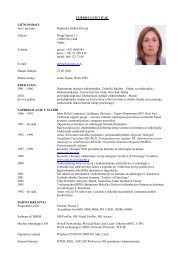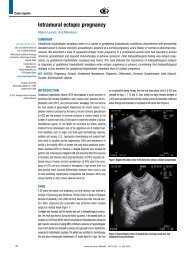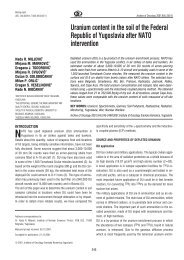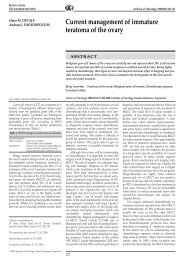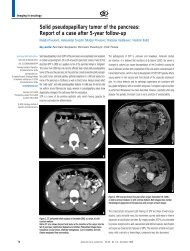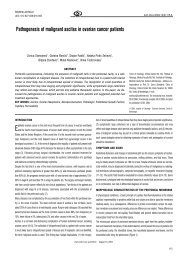Application of anti-CD20 monoclonal antibodies in the ... - doiSerbia
Application of anti-CD20 monoclonal antibodies in the ... - doiSerbia
Application of anti-CD20 monoclonal antibodies in the ... - doiSerbia
Create successful ePaper yourself
Turn your PDF publications into a flip-book with our unique Google optimized e-Paper software.
Review articles<br />
Rituximab for aggressive NHLs<br />
Aggressive NHLs require, which is <strong>the</strong> current standard, eight cycles <strong>of</strong> rituximab<br />
plus CHOP chemo<strong>the</strong>rapy. The improvement <strong>of</strong> overall survival <strong>in</strong> <strong>the</strong><br />
GELA LNH-98.5 study was <strong>of</strong> such a magnitude that statistical significance was<br />
achieved after only 12 months <strong>of</strong> follow-up (6). The benefit was ma<strong>in</strong>ta<strong>in</strong>ed for<br />
as long as 4 years, which confirmed <strong>the</strong> superiority <strong>of</strong> <strong>the</strong> comb<strong>in</strong>ed treatment.<br />
These results were later confirmed by <strong>the</strong> M<strong>in</strong>T study (7). The results compelled<br />
many to try to <strong>in</strong>vestigate <strong>the</strong> significance <strong>of</strong> rituximab addition to chemo<strong>the</strong>rapy<br />
<strong>in</strong> <strong>the</strong> second l<strong>in</strong>e approach. Numerous studies have demonstrated that rituximab<br />
is able to potentiate <strong>the</strong> response to <strong>the</strong>rapy and, thus, disease outcome<br />
as well, especially for <strong>the</strong> patients suitable for HDT/ASCT. Studies are on <strong>the</strong> way<br />
aim<strong>in</strong>g to def<strong>in</strong>e <strong>the</strong> role <strong>of</strong> rituximab for aggressive NHL relapses.<br />
Rituximab for mantle cell lymphoma (MCL)<br />
Patients with MCL on conventional <strong>the</strong>rapy have poor prognosis. The role <strong>of</strong><br />
rituximab and chemo<strong>the</strong>rapy comb<strong>in</strong>ation rema<strong>in</strong>s controversial <strong>in</strong> that regard.<br />
However, <strong>the</strong> comb<strong>in</strong>ation <strong>of</strong> rituximab and chemo<strong>the</strong>rapy and/or HDT/ASCT<br />
demonstrates a certa<strong>in</strong> progress. In some randomized trials, <strong>the</strong> comb<strong>in</strong>ation<br />
<strong>of</strong> CHOP and rituximab (R-CHOP) was significantly better regard<strong>in</strong>g <strong>the</strong> OR<br />
(p=0.0054) and CR (p=0.00024). However, <strong>the</strong> impact on TTF was much<br />
smaller (P=0.0131), while regard<strong>in</strong>g PFS and OS <strong>the</strong>re was no progress (8).<br />
However, <strong>the</strong> data produced by functional imag<strong>in</strong>g (FI) suggest that <strong>the</strong> quality<br />
<strong>of</strong> early remission is significant, recommend<strong>in</strong>g a new strategy <strong>of</strong> HDT/ASCR<br />
<strong>the</strong>rapy (9). In <strong>the</strong> study OSHO#39, <strong>the</strong> comb<strong>in</strong>ation <strong>of</strong> R-MCP (mitoxantrone,<br />
chlorambucil, prednisolone) was not superior to MCP chemo<strong>the</strong>rapy<br />
alone. The conclusion can be drawn that immunochemo<strong>the</strong>rapy is not a<br />
mandatory option for this entity with poor prognosis (10). The European MCL<br />
Network has stressed that immunochemo<strong>the</strong>rapy resulted <strong>in</strong> high RRs <strong>in</strong> two<br />
prospective <strong>in</strong>ternational trials (MCL elderly and MCL younger). Fur<strong>the</strong>r <strong>in</strong>vestigation<br />
will determ<strong>in</strong>e <strong>the</strong> role <strong>of</strong> rituximab <strong>in</strong> <strong>the</strong> ma<strong>in</strong>tenance <strong>the</strong>rapy (11).<br />
Rituximab for CLL<br />
In recent years, none <strong>of</strong> <strong>the</strong> cl<strong>in</strong>ical trials has demonstrated any survival<br />
advantage <strong>of</strong> various chemo<strong>the</strong>rapy regimens. Never<strong>the</strong>less, some new<br />
agents possess <strong>the</strong> potential to overcome this barrier. First, it has been shown<br />
that rituximab 500 mg/m 2 added to chemo<strong>the</strong>rapy improves overall survival<br />
compared to chemo<strong>the</strong>rapy alone (serv<strong>in</strong>g as a history control) (12). The best<br />
results were observed <strong>in</strong> a group <strong>of</strong> patients demonstrat<strong>in</strong>g molecular remission<br />
<strong>of</strong> <strong>the</strong> disease (MRD). Then, a phase III study CLL8 was designed, which<br />
demonstrated that rituximab 500 mg/m 2 plus chemo<strong>the</strong>rapy significantly<br />
improves PFS compared to chemo<strong>the</strong>rapy alone as <strong>the</strong> first l<strong>in</strong>e <strong>of</strong> treatment<br />
(13). PFS was improved <strong>in</strong> patients with 17p deletion and unmutated IgVH as<br />
well, o<strong>the</strong>rwise be<strong>in</strong>g <strong>the</strong> groups with very poor prognosis (14). The studies<br />
<strong>of</strong> alternative comb<strong>in</strong>ations such as rituximab plus bendamust<strong>in</strong>e as <strong>the</strong> first<br />
l<strong>in</strong>e approach are on <strong>the</strong> way, and <strong>the</strong> results <strong>of</strong> first <strong>in</strong>terim analysis <strong>of</strong> <strong>the</strong><br />
CLL 208 study, with chlorambucil added to rituximab, are eagerly awaited for.<br />
New <strong>anti</strong>-<strong>CD20</strong> <strong>anti</strong>bodies<br />
A group <strong>of</strong> new <strong>anti</strong>-<strong>CD20</strong> <strong>monoclonal</strong> „second generation“ <strong>anti</strong>bodies, is <strong>in</strong><br />
<strong>the</strong> phase <strong>of</strong> pre-cl<strong>in</strong>ical and cl<strong>in</strong>ical <strong>in</strong>vestigation. Atumubab is a IgG1 <strong>anti</strong>body<br />
with some characteristics <strong>of</strong> type I <strong>anti</strong>bodies, mean<strong>in</strong>g that when it b<strong>in</strong>ds to<br />
<strong>CD20</strong> it <strong>in</strong>duces its own translocation <strong>in</strong>to a detergent-<strong>in</strong>soluble layer, which is<br />
associated with complement activation and CDC type <strong>of</strong> elim<strong>in</strong>ation <strong>of</strong> tumor<br />
cells. In contrast to rituximab, it has a full human sequence and it b<strong>in</strong>ds to <strong>the</strong><br />
epitope, which is <strong>in</strong> a more compact way bound to <strong>the</strong> cell membrane with<br />
prolonged action (15). Ofatumomab is a subject <strong>of</strong> numerous cl<strong>in</strong>ical trials.<br />
One <strong>of</strong> <strong>the</strong> segments is a phase I/II study <strong>of</strong> <strong>the</strong> patients with recurrent follicular<br />
lymphomas (16). Its toxicity is similar to <strong>the</strong> toxicity <strong>of</strong> rituximab, and responses<br />
have been achieved even <strong>in</strong> patients on rituximab treatment. The CDC effect has<br />
been observed <strong>in</strong> CLL too <strong>in</strong> phase I/II studies. In o<strong>the</strong>r studies, <strong>the</strong> patients<br />
with disease progression on fludarab<strong>in</strong>e and alemtuzumab have been analyzed.<br />
Veltuzumab (hA20) is a humanized IgG1 <strong>monoclonal</strong> <strong>anti</strong>body target<strong>in</strong>g <strong>the</strong><br />
identical epitope as rituximab (17). The results are similar to <strong>the</strong> ones rituximab<br />
achieves, but with lower dosage than rituximab. GA101 is a type II <strong>anti</strong>body,<br />
generated, similar to many o<strong>the</strong>rs, <strong>in</strong> <strong>the</strong> Ch<strong>in</strong>ese hamster ovary (CHO) cells.<br />
This <strong>anti</strong>body, <strong>in</strong> addition to <strong>the</strong> ADCC mechanism, has <strong>the</strong> properties <strong>in</strong>creas<strong>in</strong>g<br />
<strong>the</strong> apoptosis-<strong>in</strong>duced activity (18). AME-133 is a human IgG1 <strong>anti</strong>body with<br />
high aff<strong>in</strong>ity for <strong>CD20</strong> and <strong>the</strong> ability to b<strong>in</strong>d to CD16 via its Fc region, effectuat<strong>in</strong>g<br />
5 to 10 times higher aff<strong>in</strong>ity than rituximab (19). Precl<strong>in</strong>ical <strong>in</strong>vestigations<br />
have demonstrated also a larger effect upon <strong>the</strong> NK-cell activation. Special<br />
benefit from this will perhaps have <strong>the</strong> patients with a suboptimal status <strong>of</strong><br />
immune effector cells. The common elements <strong>of</strong> this new group <strong>of</strong> <strong>monoclonal</strong><br />
<strong>anti</strong>bodies (<strong>in</strong>clud<strong>in</strong>g PRO 131921 as well) are that <strong>the</strong>se are all human/humanized<br />
<strong>anti</strong>-<strong>CD20</strong> <strong>monoclonal</strong> <strong>anti</strong>bodies designed to b<strong>in</strong>d to new epitopes, that<br />
<strong>the</strong>y <strong>in</strong>crease ADCC, CDC, b<strong>in</strong>d<strong>in</strong>g to <strong>CD20</strong>, or apoptosis activation.<br />
Radioimmuno<strong>the</strong>rapy<br />
Radioimmuno<strong>the</strong>rapy <strong>in</strong>volves <strong>the</strong> adm<strong>in</strong>istration <strong>of</strong> <strong>anti</strong>bodies labeled with a<br />
radioisotope, enabl<strong>in</strong>g <strong>the</strong> destruction <strong>of</strong> cells present<strong>in</strong>g <strong>the</strong> target <strong>anti</strong>gen,<br />
but also <strong>the</strong> adjacent cells, which do not express enough <strong>anti</strong>gens to b<strong>in</strong>d<br />
<strong>the</strong> <strong>anti</strong>body. The concept was <strong>in</strong>troduced by De Nardo et al. HLA <strong>anti</strong>gens<br />
on <strong>the</strong> cells <strong>of</strong> aggressive non-Hodgk<strong>in</strong> lymphomas were <strong>the</strong> first target,<br />
utiliz<strong>in</strong>g radio-labeled <strong>anti</strong>bodies aga<strong>in</strong>st Lym-1 and achiev<strong>in</strong>g sporadic<br />
complete remissions (20). Nowadays, two radioconjugates target<strong>in</strong>g <strong>CD20</strong><br />
are available, Yttrium-90 ( 90 Y)-labeled IBRUTUMOMAB TIUXETAN (Zeval<strong>in</strong>,<br />
Cell Therapeutics) and Iod<strong>in</strong>e-131 ( 131 J)-labeled TOZITUMOMAB (Bexxar,<br />
GlaxoSmithKl<strong>in</strong>e). They are approved for <strong>the</strong> patients with relapsed/recurrent<br />
follicular or low-evolutionary lymphomas (21).<br />
CONCLUSION<br />
Therapeutic use <strong>of</strong> <strong>anti</strong>-<strong>CD20</strong> <strong>monoclonal</strong> <strong>anti</strong>bodies has demonstrated a<br />
significant benefit <strong>in</strong> <strong>the</strong> patients with lymphoproliferative diseases. Rituximab<br />
is today a golden standard for <strong>the</strong> comparison with o<strong>the</strong>r treatment modalities,<br />
<strong>in</strong>creas<strong>in</strong>gly <strong>in</strong> comb<strong>in</strong>ation with chemo<strong>the</strong>rapy. New <strong>anti</strong>-<strong>CD20</strong> agents<br />
provide both potentially higher activity characteristic for rituximab and different<br />
targets, creat<strong>in</strong>g <strong>the</strong> possibility to be comb<strong>in</strong>ed with rituximab. New<br />
prospective cl<strong>in</strong>ical studies, especially with patients refractory to rituximab,<br />
will provide appropriate answers to <strong>the</strong>se questions. Radiolabeled <strong>anti</strong>bodies<br />
can prove to be useful <strong>in</strong> patients resistant to rituximab.<br />
Conflict <strong>of</strong> <strong>in</strong>terest<br />
We declare no conflicts <strong>of</strong> <strong>in</strong>terest.<br />
REFERENCES<br />
1 Matutes E, Polliack A. Morphological and immunophenotypic features <strong>of</strong> chronic<br />
lymphocytic leukemia. Rev Cl<strong>in</strong> Exp Hematol. 2000;4:22-47.<br />
66<br />
www.onk.ns.ac.rs/Archive Vol 17, No. 3-4, December 2009




